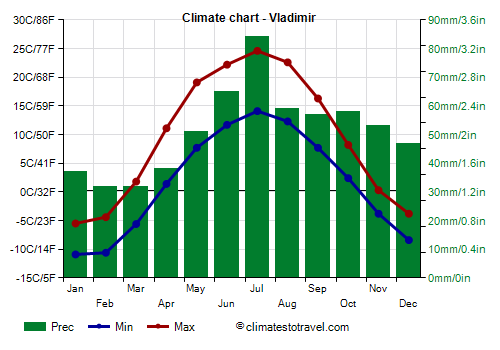Select units of measurement for the temperature and rainfall tables (metric or imperial).
Average weather, temperature, rainfall, sunshine hours

The climate of Vladimir is
continental, with very cold winters and relatively warm summers.
Vladimir is a city of 350,000 inhabitants, the capital of the oblast' of the same name, located in European Russia, on the banks of the Klyazma River, at 56 degrees north latitude and 170 km (105 mi) east-northeast of Moscow.
Precipitation is not abundant, since it amounts to about 615 millimeters (24 inches) per year. As often happens in cold climates, the rainiest season is summer.
The climate of Vladimir is actually similar to that of Moscow, although winter temperatures can be a little lower, especially at night, as there is no heat island typical of big cities.
Winter, from November to March, is very cold: the average temperature in January and February is around -8 °C (17.5 °F). The sky is often cloudy, and light snow often falls.
The ground is usually covered in snow, although there may be periods when the temperature rises above freezing, usually only slightly, and rain, drizzle or rain mixed with snow can occur.
During
cold spells, the temperature drops to around -20 °C (-4 °F) or below almost every year, and can sometimes drop below -30 °C (-22 °F).
The coldest record is -47.5 °C (-53.5 °F), set in January 1940. At the end of December 1978, the temperature dropped to -43 °C (-45.4 °F).
The coldest month was January 1987, with a daily average of -21.2 °C (-6.2 °F).
On the other hand, in the exceptionally mild winter of 2020, the daily average from December to February was 0 °C (32 °F), and the extreme minimum for the entire season was -19.7 °C (-3.5 °F), and it only dropped below -10 °C (14 °F) for two days.
Summer, from June to August, is very mild or pleasantly warm, with an acceptable amount of sunshine, but also with fairly frequent rains and thunderstorms. The average in July is 19 °C (66 °F).
Sometimes there can be
very hot periods in which the temperature reaches or exceeds 32/33 °C (90/91 °F). The hottest record is 37.1 °C (98.9 °F), set in August 2010. The summer of 2010 was remarkably hot, so much so that the average maximum temperature in July was 31.5 °C (88.7 °F).
Vladimir - Climate data
In Vladimir, the
average temperature of the coldest month (January) is of
-8.2 °C, that of the warmest month (July) is of
19.4 °C. Here are the average temperatures.
Vladimir - Average temperatures (1991-2020) |
| Month | Min | Max | Mean |
|---|
| January | -10.9 | -5.5 | -8.2 |
|---|
| February | -10.6 | -4.4 | -7.5 |
|---|
| March | -5.6 | 1.8 | -1.9 |
|---|
| April | 1.4 | 11.1 | 6.2 |
|---|
| May | 7.7 | 19.1 | 13.4 |
|---|
| June | 11.7 | 22.2 | 17 |
|---|
| July | 14.1 | 24.6 | 19.4 |
|---|
| August | 12.3 | 22.6 | 17.5 |
|---|
| September | 7.7 | 16.3 | 12 |
|---|
| October | 2.4 | 8.2 | 5.3 |
|---|
| November | -3.8 | 0.3 | -1.8 |
|---|
| December | -8.4 | -3.8 | -6.1 |
|---|
| Year | 1.6 | 9.5 | 5.5 |
|---|
amounts to
615 millimeters per year: so, it is at an intermediate level. It ranges from
32 millimeters in the driest months (February, March) to
84 millimeters in the wettest one (July). Here is the average precipitation.
Vladimir - Average precipitation| Month | Days |
|---|
| January | 37 | 10 |
|---|
| February | 32 | 8 |
|---|
| March | 32 | 8 |
|---|
| April | 38 | 8 |
|---|
| May | 51 | 8 |
|---|
| June | 65 | 10 |
|---|
| July | 84 | 10 |
|---|
| August | 59 | 9 |
|---|
| September | 57 | 10 |
|---|
| October | 58 | 10 |
|---|
| November | 53 | 11 |
|---|
| December | 47 | 11 |
|---|
| Year | 615 | 113 |
|---|
There are on average around 2000
sunshine hours per year. Here are the average hours of sunshine per day.
Vladimir - Sunshine hours| Month | Average | Total |
|---|
| January | 1.5 | 50 |
|---|
| February | 3 | 90 |
|---|
| March | 5 | 150 |
|---|
| April | 7 | 205 |
|---|
| May | 9.5 | 300 |
|---|
| June | 10.5 | 320 |
|---|
| July | 10 | 310 |
|---|
| August | 8.5 | 260 |
|---|
| September | 5.5 | 160 |
|---|
| October | 3 | 90 |
|---|
| November | 1.5 | 40 |
|---|
| December | 1 | 30 |
|---|
| Year | 5.5 | 2000 |
|---|